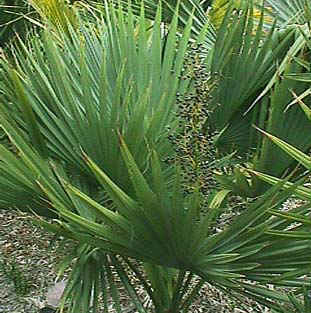Contents:
Common Names | Parts Usually Used | Plant(s) & Culture | Where Found | Medicinal Properties | Biochemical Information
Uses | Formulas or Dosages | How Sold | Warning | Resource Links | Bibliography
Scientific Names

- Serenoa serrulata L.
- Palm family
Common Names
- Dwarf palmetto
- Pan palm
Parts Usually Used
Berries
Back to Top
Description of Plant(s) and
Culture
Saw palmetto is a low, shrubby plant grows to 6 feet; the trunk or rootstock remains below the ground, producing palmate, green to white-coated leaves on saw-toothed petioles. Has horizontal creeping stems above ground. Leaves fanlike, with sword-shaped leaf blades radiating from a central point. Flowers are whitish green, with 3-5 petals; May to July. The olive-like, dark-purple to black fleshy berries, 1 inch long, surrounding one large seed, grow in bunches or clusters, ripening from October to December.
Back to Top
Where Found
Found growing in dense stands along the Atlantic coast in Georgia and Florida. Low pine woods, savannas, thickets. South Carolina, Georgia, Florida to Alabama, Mississippi.
Back to Top
Medicinal Properties
Antiseptic, cardiac, diuretic, expectorant, sedative, tonic
Back to Top
Biochemical Information
Essential oil, fatty oil, with capric, caprylic and lauric acids, fatty acids, carotene, tannin, sitosterol invert sugar, estrogenic substance.
Back to Top
Uses
The berries are particularly useful for conditions associated with colds, hayfever, asthma, and bronchitis. Catarrhal problems and mucous congestion respond to a tea made from the dried berries. The tea has also been recommended as a general tonic to build strength during convalescence from illness. Used for colds, coughs, inflammations, coughs, irritated mucous membranes, tickling feeling in the throat, migraine. A suppository of the powdered fruits in cocoa butter was used as a uterine and vaginal tonic. Saw palmetto is considered by some to have aphrodisiac powers. Said to improve prostate health (combined with echinacea). Used to treat “honeymoon cystitis” in females. Although the FDA does not recognize this herb as an effective drug, in Germany it is sold over-the-counter as a treatment for benign prostate problems. Benign prostate enlargement can cause excessive urination in men, especially annoying at night.
Back to Top
Formulas or Dosages
Infusion: steep 1 tsp. dried berries in 1 cup water. Take 1-2 cups a day.
Tincture: a dose is from 30-60 drops.
Extract: mix 30 to 60 drops in liquid per day.
Back to Top
How Sold
Fruit extracts, capsules, tablets, tincture.
Back to Top
Warning
Any man experiencing pain or swelling of the prostate, or has difficulty urinating, or passes any blood in the urine, should be examined by a medical physician ASAP.
Back to Top
Resource Links
LiveStrong.com: About Saw Palmetto for Women
Medicinal Herb Info Blog: Organically Grown Saw Palmetto
University of Maryland Medical Center: Saw Palmetto
American Cancer Society: Saw Palmetto
American Academy of Family Physicians: Saw Palmetto
National Center for Complementary and Alternative Medicine: Saw Palmetto
Memorial Sloan-Kettering Cancer Center: Saw Palmetto
Bibliography
![]() Eastern/Central Medicinal Plants
Eastern/Central Medicinal Plants, by Steven Foster and James A. Duke., Houghton Mifflin Company, 215 Park Avenue South, New York, NY 10000
![]() The Complete Medicinal Herbal
The Complete Medicinal Herbal, by Penelope Ody, Dorling Kindersley, Inc, 232 Madison Avenue, New York, NY 10016, First American Edition, copyright 1993
![]() Back to Eden
Back to Eden, by Jethro Kloss; Back to Eden Publishing Co., Loma Linda, CA 92354, Original copyright 1939, revised edition 1994
![]() Indian Herbalogy of North America
Indian Herbalogy of North America, by Alma R. Hutchens, Shambala Publications, Inc., Horticultural Hall, 300 Massachusetts Avenue, Boston, Massachusetts 02115, 1973
 Earl Mindell’s Herb Bible
Earl Mindell’s Herb Bible, by Earl Mindell, R.Ph., Ph.D., Simon & Schuster/Fireside, Rockefeller Center 1230 Avenue of the Americas, New York, New York 10020
![]() Planetary Herbology
Planetary Herbology, by Michael Tierra, C.A., N.D., O.M.D., Lotus Press, PO Box 325, Twin Lakes. WI 53181., Copyright 1988, published 1992
![]() American Folk Medicine
American Folk Medicine, by Clarence Meyer, Meyerbooks, publisher, PO Box 427, Glenwood, Illinois 60425, 1973
![]() The Herb Book
The Herb Book, by John Lust, Bantam Books, 666 Fifth Avenue, New York, NY. copyright 1974.
![]() Webster’s New World Dictionary
Webster’s New World Dictionary, Third College Edition, Victoria Neufeldt, Editor in Chief, New World Dictionaries: A Division of Simon & Schuster, Inc., 15 Columbus Circle, New York, NY 10023
![]() The Yoga of Herbs: An Ayurvedic Guide to Herbal Medicine
The Yoga of Herbs: An Ayurvedic Guide to Herbal Medicine, by Dr. David Frawley & Dr. Vasant Lad, Lotus Press, Twin Lakes, Wisconsin, Second edition, 1988.
 A Useful Guide to Herbal Health Care
A Useful Guide to Herbal Health Care, HCBL (Health Center for Better Living).,1414 Rosemary Lane, Naples, FL 34103., Special Sale Catalog, 1996
